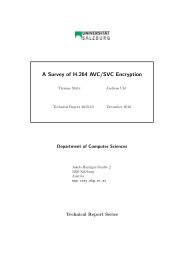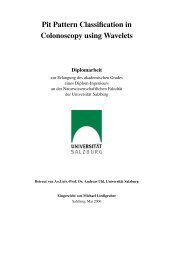Single-sensor hand and footprint-based multimodal biometric ...
Single-sensor hand and footprint-based multimodal biometric ...
Single-sensor hand and footprint-based multimodal biometric ...
Create successful ePaper yourself
Turn your PDF publications into a flip-book with our unique Google optimized e-Paper software.
2 Biometric system design<br />
When designing <strong>biometric</strong> systems, a number of questions need to be addressed, such as<br />
comparison mode (verification vs. identification), operational mode (automatic vs. semiautomatic),<br />
the selection of one or many modalities according to the needs of the application<br />
<strong>and</strong> hardware for sensing these modalities [21]. The awareness of the target application<br />
is crucial for the design of <strong>biometric</strong> systems. In the case of <strong>h<strong>and</strong></strong>- <strong>and</strong> <strong>footprint</strong>-<strong>based</strong><br />
systems, it is important to notice that evidently their target applications may be quite<br />
different. While <strong>multimodal</strong> <strong>h<strong>and</strong></strong>-<strong>based</strong> <strong>biometric</strong>s perfectly fits into the mainstream of<br />
authentication applications, foot <strong>biometric</strong>s is too time-consuming in environments where<br />
users have to take off shoes first. Thus, the explicit definition of a target application for<br />
foot <strong>biometric</strong>s is needed. A good way to identify target applications is to formulate conditions<br />
on application domains. When the domain is found, it can be classified according<br />
to characteristics introduced by Wayman [40] (namely cooperative vs. non-cooperative,<br />
overt vs. covert, habituated vs. non-habituated, attended vs. non-attended, st<strong>and</strong>ard vs.<br />
non-st<strong>and</strong>ard, public vs. private, <strong>and</strong> open vs. closed), that further help to justify the<br />
selection of specific features.<br />
The first question arising naturally when dealing with new modalities, such as <strong>footprint</strong>s,<br />
is “Why do we need a new modality?”. There are many accurate techniques <strong>and</strong> foot<br />
biometry has largely been neglected so far, so the answer to this question is not obvious.<br />
However, when privacy interests of users are considered, <strong>footprint</strong>-<strong>based</strong> authentication<br />
might be the right choice, since it is not employed in high-security applications. Second,<br />
foot <strong>biometric</strong>s is closely related to <strong>h<strong>and</strong></strong> geometry, palmprint <strong>and</strong> fingerprints. Many of<br />
the <strong>biometric</strong> techniques using the human <strong>h<strong>and</strong></strong> or parts thereof can be translated to this<br />
new domain. In contrast to <strong>h<strong>and</strong></strong> geometry, a <strong>footprint</strong>-<strong>based</strong> identification system may<br />
be implemented in covert mode (i.e. without awareness of the user that the <strong>biometric</strong> is<br />
taken [40]), if certain prerequisites are met (such as in environments where users walk on<br />
bare feet). It is, in fact, the only known covert <strong>biometric</strong> without being captured at a<br />
distance. To identify target application domains for <strong>footprint</strong>-<strong>based</strong> authentication, the<br />
following prerequisites should be met:<br />
• low throughput should be avoided by choosing environments, where users already<br />
walk on bare feet;<br />
• unhygienic recording conditions should be avoided;<br />
• large space for the <strong>sensor</strong> has to be provided, i.e. foot <strong>biometric</strong> <strong>sensor</strong>s can not<br />
be integrated into small devices (such as PDAs, notebooks);<br />
• privacy interests should justify the selection of <strong>footprint</strong>s as the identifier of choice.<br />
7








